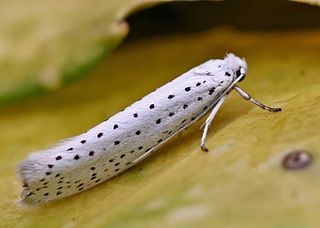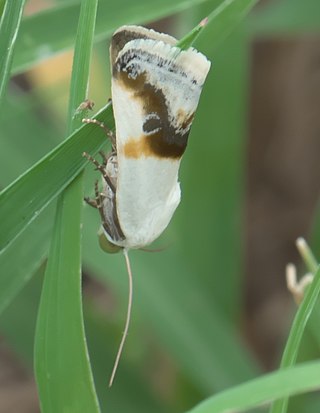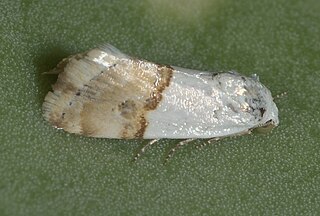
The luna moth, also called the American moon moth, is a Nearctic moth in the family Saturniidae, subfamily Saturniinae, a group commonly named the giant silk moths.

The family Yponomeutidae are known as the ermine moths, with several hundred species, most of them in the tropics. The larvae tend to form communal webs, and some are minor pests in agriculture, forestry, and horticulture. Adult moths are minor pollinators.

Biston strataria, the oak beauty, is a moth of the family Geometridae. It is native to Europe, the Balkan countries and the Black Sea region as far as Asia Minor and the Caucasus. The species was first described by Johann Siegfried Hufnagel in 1767. B. strataria is found in a variety of habitats, but is mostly found in woodlands where it rests on the bark of trees, camouflaged by its mottled black and grey wings. The male has feather-like antennae while those of the female are more thread-like. The moth has a wingspan of 40 to 56 mm.
Tarachidia was a genus of moths of the family Noctuidae, it is now considered a synonym of Ponometia.

Ponometia exigua is a moth of the family Noctuidae first described by Johan Christian Fabricius in 1793. It is found from Georgia, south to Florida and west to Texas. Outside of the United States it is found in Jamaica, Cuba, Hispaniola, the Virgin Islands and Central America and South America down to Brazil.

Ponometia semiflava, the half-yellow or yellow-cloaked midget, is a moth of the family Noctuidae. The species was first described by Achille Guenée in 1852. It is found in North America from New York and New England to Florida, west to Arizona, north to British Columbia and Manitoba.

Ponometia altera is a moth of the family Noctuidae. It is found in the southern parts of the United States, including New Mexico, Arizona and California.

Ponometia candefacta, the olive-shaded bird-dropping moth, is a moth of the family Noctuidae. It is found in North America, where it has been recorded from the northern United States to southern Mexico. It has been introduced to Russia as a biological control agent of Ambrosia artemisiifolia. The habitat consists of dry, weedy, disturbed areas at low elevations.
Ponometia septuosa is a species of bird dropping moth in the family Noctuidae. It is found in North America.
Ponometia virginalis is a species of bird dropping moth in the family Noctuidae. It is found in North America, where it has been recorded from eastern Texas to Nebraska, west to eastern Arizona in the south, and to Utah, Colorado, and Wyoming in the west.
Ponometia clausula is a species of bird dropping moth in the family Noctuidae.

Ponometia binocula, the prairie bird-dropping moth, is a bird dropping moth in the family Noctuidae. The species was first described by Augustus Radcliffe Grote in 1875.
Ponometia sutrix is a species of bird dropping moth in the family Noctuidae. It is found in North America.
Ponometia pulchra is a species of bird-dropping moth in the family Noctuidae. It was first described by William Barnes and James Halliday McDunnough in 1910 and it is found in North America.
Ponometia nigra is a species of bird dropping moth in the family Noctuidae. It is found in North America.
Ponometia acutus is a species of bird dropping moth in the family Noctuidae.

Ponometia libedis is a bird dropping moth in the family Noctuidae. The species was first described by Smith in 1900.

Ponometia elegantula, the Arizona bird dropping moth, is a species of bird dropping moth in the family Noctuidae. The species was first described by Leon F. Harvey in 1876.
Ponometia tortricina is a species of bird dropping moth in the family Noctuidae.







